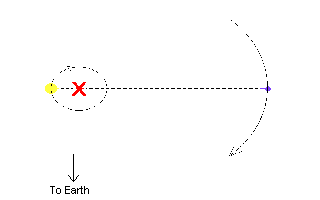
|
Detecting New Extrasolar Planets
Methods of Discovery
|
|
|
Numerous projects now exist in the ongoing attempt to detect new planets. This page explains the methods used for discovery of extrasolar systems.
The Doppler Effect
Most new planets to date have been detected by doppler shift measurements. This method of planetary detection is also known as the "wobble effect". A planet orbiting a sun causes a gravitational pull on the star. As the planet orbits, the both the star and the planet circle around a center of gravity point between the two objects.

Doppler shift wobble effect diagram
In the picure above, the larger yellow dot represents the star or sun, and the smaller blue dot represents a planet orbiting the sun. Both the star and the planet pivot around the centre of gravity marked my the red X. As the star circles around the center of gravity, at times it will appear to be travelling toward the earth relatively, and at times it will appear to be travelling away from the earth. The doppler effect is the apparent change in frequency or wavelength of waves perceived by observations, from Earth. As the star appears to travel toward the Earth, the light waves that we see are shifted toward the short-wavelength blue end of the spectrum. As the star appears to travel away from thr Earth, the light waves that we see are shifted toward the longer-wavelength and at the red end of the spectrum.
Astrometry
The word astrometry is derived from from the Greek word 'a`stron, meaning star and meter, which means measure. When searching for new planets, astrometry involves measuring the proper motion of a star in the search for movement caused by its planets. The proper motion is the motion caused by the true movement of the stars, the Sun and solar system through space. This method requires very precise measurements of a star's position in the sky to detect any extremely slight movement away from its expected motion. Astrometry is the oldest method used in the attempts to search for extrasolar planets, and was used as early as 1943. A number of candidates have been found since but none of them have been confirmed, and most astronomers have abandoned this method for more successful ones. However, the field of astrometry has progressed greatly with the launch of space-based observatories which can now make extremely precise measurements.
|
|
Pulsar timing
This was the method used by Aleksander Wolszczan to discover of the first planet, and first stellar system outside of our own, by. It also lead to the discovery of the oldest known planet, by Steinn Sigurdsson's team, around PSR B1620-26's binary stellar core. This planet is the only known planet to orbit two stars. The pulsar timing method involves very precise measurements of the signal of a pulsar in order to establish if there are any timing anomalies in the period of the pulses. Subsequent calculations are used to establish what could cause the anomalies. This method is commonly used to find pulsar companions but is not used specifically with the intention to find planets.
Photometry (The Transit Method)
The Transit Method is a relatively recent method of detecting extrasolar planets. It uses the same effect and principles as occur when the moon eclipses the sun - it detects the temporary dimming of the star as a planet transits in front of its host star. If the dimming occurs at regular periods, it is probable that an orbiting planet is causing the effect. The transit method will only work for a small percentage (probably less than 1%) of extrasolar planets, as the orbits need to be perfectly aligned from our vantage point. However, a large number of stars can be studied at once to see which ones fade periodically over time. Another large advantage is that it can be used on very distant stars however. Most new planets found so far are of relatively high mass (at least 40 times the mass of the Earth) but this method is hoped to lead to the first detection of an Earth-size planet when employed by NASA's forthcoming space-based Kepler telescope, set to launch in 2007. The Kepler space observatory is designed specifically to search large numbers of stars for Earth-sized terrestrial planets using the transit method.
Circumstellar disks
An even newer approach than The Transit Method is the study of dust clouds. Many solar systems contain a significant amount of space dust that exists due to frequent dust generation activity such as comets, asteroids and the planetary collisions. This dust forms as a disc around a star and absorbs regular star light and re-emits it as infrared radiation. By studying the dust cloud density and distortion, caused either by an orbiting planet "catching" the dust, or distortion due to gravitational influences of orbiting planets, invaluable information gan be gained. Our own solar system contains enough dust to make up about 1/10th the mass of the Earth's moon. Despite this mass being negligible its surface area is so great that at a distance, its infrared emissions would outshine all of the planets in the solar system by a factor of 100. Unfortunately this method can only be used by space based observations, due to the fact that the Earth's atmosphere absorbs most infrared radiation making ground based observation unviable.
© Piglette.com
|
|
|